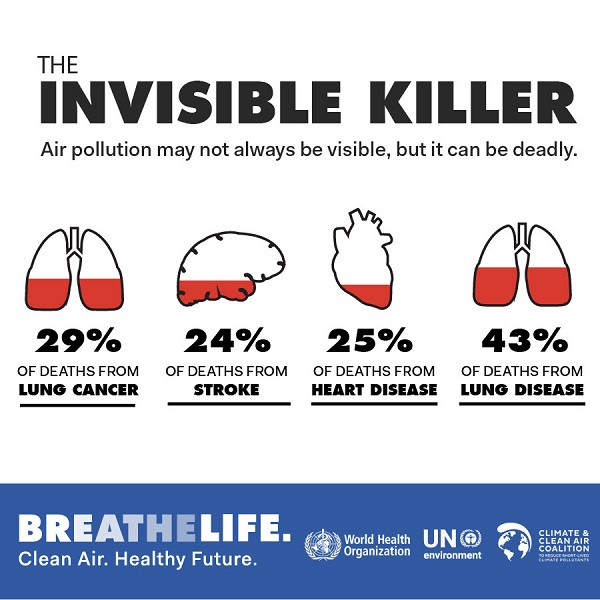
Air Pollution is one of the major environmental risk factors for the global burden of disease and updated estimates put the death toll as high as 7 million people per year. Public health professional Ramya Kancharla recommends steps you can take to reduce air pollution and how you can limit your exposure to air pollution.
Air pollution is a serious public health concern - and one that you’re likely battling with on an everyday basis, both inside and outside your home. Air pollution is now the leading environmental health risk worldwide. The World Health Organization (WHO) estimates that nine out of ten people now breathe polluted air.
Air pollution – both indoor and outdoor – is estimated to kill a staggering 7 million people every year1. Microscopic particles in polluted air can penetrate deep into the lungs and cardiovascular system, causing diseases including stroke, heart disease, chronic obstructive pulmonary disease, lung cancer and acute respiratory infections.
Download COPD Management and Asthma Management E-Books

Recent studies have shown that air pollution may also be affecting our mental health and well-being. Studies have shown that air pollutions is linked to reduced cognitive ability among children, increased risk of cognitive decline among adults, and possibly even contribute to depression2. There is also growing evidence that exposure to polluted air, especially traffic related pollutants, is associated with increased risk of Alzheimer’s disease and other dementias in older persons3.
The main substances in polluted air that effect our health are nitrogen oxides, sulphur oxides, ozone and particulate matter. Particulate matter, especially below 2.5 microns (PM 2.5) is of the greatest concern, as these tiny particles penetrate deep into the lungs, affecting both the respiratory and vascular systems4.
Air pollution threatens all of us but it is the most vulnerable sections of our population that face the gravest danger. Those at highest risk include: persons with heart and lung diseases, pregnant women and young children, the elderly, and outdoor workers. People in these groups may experience health impacts at lower air pollution exposure levels, or their health effects may be of greater intensity5.
It is a common misconception that if the air is clear/not hazy, then it is not polluted. Unfortunately, this is not true. While very high concentrations of air pollution can form visible haze and smog, most of the air pollution we experience is at concentrations that are invisible and odourless. There is no safe level of air pollution. Studies demonstrate that there is no threshold below which population risk of illness is not elevated6. You can use this online pollution meter to better understand the level of air pollution in your city, so that you can take the action necessary to protect your health.
The WHO suggests that air pollution can be significantly reduced by “expanding access to clean household fuels and technologies, as well as prioritizing: rapid urban transit, walking and cycling networks; energy-efficient buildings and urban design; improved waste management; and electricity production from renewable power sources7”. But what can you do at the individual or household level to protect yourself and your family from air pollution?
Five Ways to Limit Exposure to Air Pollution6 8
1. Assess your risk: You need to be understand if any existing health conditions make you more susceptible to air pollution; check with a doctor if necessary. This can help you weigh and balance the risks and benefits of exposure.
2. Use effective protection: If a face mask is advised where you live, consult with credible sources to be sure it has a strong enough filter. The effectiveness of respirators and face masks depends on the type of pollutants, mask design and how they are used. It is important to keep in mind that no air-filter or face mask will eliminate all the air pollutants from the air, especially ultrafine matter which is among the most harmful.
3. Monitor the air in your area: Check the level of air pollution in your city each day to determine whether you need to limit your outdoor activity or if you need to avoid particular areas in your region where air pollution levels may be particularly high.
4. Avoid rush hour: Try to avoid or limit outdoor activity during rush hour. For example, try to avoid walking on busy streets during rush hour; and if you have a child with you, try to lift them up above the level of the vehicle exhausts. If you’re inside your car during rush hour or in heavy traffic, keep your windows closed.
5. Know your surroundings: Be mindful of your surroundings when planning outdoor activities. Avoid pollution hotspots such as traffic lights or busy highways. If you’re doing physical activity outdoors, try exercising in less polluted areas.
How To Boost Immunity Against Air Pollution
Five Ways to Contribute to Reducing Air Pollution8 9
1. Rethink your commute: Use public transportation, cycling, walking or carpooling whenever possible to get around. If a car is necessary, consider an electric or plug-in hybrid electric vehicles or other low emission alternatives. Diesel vehicles are a large contributor to pollution.
2. Conserve energy: Try to use energy efficient lights and appliances, whether at home or work. Remember to turn off lights and appliances when not in use. Remember to turn off lights and appliances when not in use. Run dishwashers and washing machines only when full. Switch to renewable energy sources where possible.
3. Manage waste: Don’t burn trash as this contributes directly to air pollution. Try to compost food and garden waste. Try to recycle non-organic waste. Reuse or repurpose materials when possible.
4. Clean cooking: Coal and wood cause indoor air pollution when used for cooking (for example, using a woodstove) and outdoor pollution when used for heating (for example, using a wooden fireplace).
5. Advocate for change: Reach out to your local representatives and urge them to support adoption of air quality standards that meet WHO guidelines. Support policies that reduce emissions from power plants, strengthen emissions standards and encourage the purchase and use of cleaner and energy efficient products.
By staying informed and incorporating these practices, we can limit our contribution and exposure to air pollution, and protect our heath and that of our loved ones.

Ramya Kancharla is a public health professional. In her current role at Vital Strategies, she works closely with city governments across Asia in the areas of non-communicable diseases, injury prevention and environmental health.
References
- https://www.who.int/news-room/detail/02-05-2018-9-out-of-10-people-worldwide-breathe-polluted-air-but-more-countries-are-taking-action
- https://www.apa.org/monitor/2012/07-08/smog
- https://www.ncbi.nlm.nih.gov/pmc/articles/PMC6138768/
- https://www.unece.org/environmental-policy/conventions/envlrtapwelcome/cross-sectoral-linkages/air-pollution-and-health.html
- http://www.sparetheair.com/health.cfm
- https://environmentalhealth.vitalstrategies.org/
- https://www.who.int/airpollution/ambient/about/en/
- https://breathelife2030.org/solutions/actions-for-individuals/
- https://www3.epa.gov/region1/airquality/reducepollution.html






